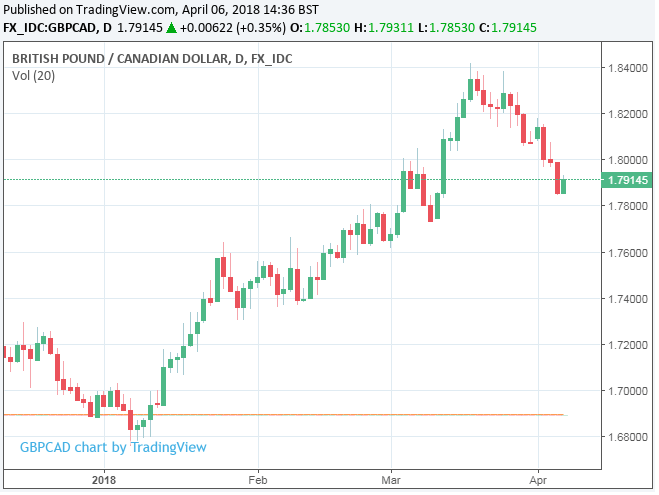Canadian Dollar Advances on Rivals after Strong Employment Data; Strategists Look to the BoC
- Written by: James Skinner
-
- Canadian unemployment holds at a post crisis low of 5.8%.
- Canadian economy adds jobs at faster than expected pace of 32.3k.
- But Canadian Dollar could soon re-establish downtrend.

© Rawpixel.com, Adobe Stock
The Canadian Dollar advanced on its developed world rivals ahead of the weekend after data showed Canada's unemployment rate holding steady and the economy adding new jobs at a faster than expected pace during March.
Canada’s economy added 32,300 new jobs during the recent month when markets had been looking for growth of just 20,100 while the unemployment rate remained at a post-crisis low of 5.8% despite suspicions among many economists that it might have risen during recent weeks. Separately, hourly wages were shown growing at a steady annualised rate of 3.1%.
Despite the 32K rise in job creation in March, the economy posted its first quarterly decline in employment since Q3 2010.
However, the details show the number of people employed full-time continued to rise (+78K) in the first three months of 2018, part-time employment posted a hefty 118K drop in the quarter, mainly due to January’s 137K plunge.
The unemployment rate and a broader measure that includes those who are underemployed fell again in the first quarter ensuring the unemployment rate averaged 5.8% in Q1, the lowest since the mid-1970s and the broader U8 measure matched the lowest on record at 8.3%.
Markets care about the data because jobs growth and unemployment changes are leading indicators of economic and wages growth, which are important for Bank of Canada inflation forecasts and therefore, market expectations around interest rates.
Canada's headline inflation rate is already above the BoC's 2% target while the more important core inflation measures rose to the 2% threshold in February so the debate about when the BoC will raise rates again has stepped up a gear in recent weeks, although not solely for these reasons.
"The absence of any acceleration in wages or drop in the jobless rate should be enough to keep the Bank of Canada on hold for now, particularly given only muted GDP growth in the most recent two months of data," says Avery Shenfeld, chief economist at CIBC Capital Markets. "Still, the contrast with a softer US payrolls report has the Canadian Dollar marginally firmer after the data, and two year yields a bit higher."
The data and the Canadian Dollar's positive reaction ensures the Pound-to-Canadian Dollar exchange rate remains on the defensive after it was rejected at multi-month highs at 1.84 last month and extends declines down to 1.79:
Above: Pound-to-Canadian-Dollar rate shown at hourly intervals.
The USD/CAD rate was quoted 0.15% lower at 1.2751 following the release after reversing an earlier gain, while the Pound-to-Canadian-Dollar rate also about turned and sank 0.09% lower to 1.7868. Meanwhile, Canada's unit marched higher against all of its other developed world rivals.
Above: USD/CAD rate shown at hourly intervals.
"The loonie comes into the March employment report sorting through a tug-of-war of conflicting drivers. The good news is that NAFTA headlines have turned more constructive, reflecting some softening of demands from the US side. The bad news is that we think this relief rally is just that rather than a reversal of fortunes for the loonie," says Fred Demers, chief Canada macro strategist at TD Securities.
Economic growth is now running at least half the level of the BoC's expectations and market pricing remains firm on 50bp worth of tightening this year.
"Despite some constructive NAFTA headlines, the softening growth story underscores the narrative that USDCAD remains a buy on dips with a push back towards 1.30 in the coming months," says Demers, hinting at the potential for Canadian Dollar weakness to re-establish.
Advertisement
Get up to 5% more foreign exchange by using a specialist provider to get closer to the real market rate and avoid the gaping spreads charged by your bank when providing currency. Learn more here.
Bank of Canada in Focus
Demers and the TD Securities team hold a bearish view on the Canadian Dollar as far as the near future goes.
They've repeatedly flagged that the Bank of Canada's tone on interest rates is dictated more by economic growth momentum than current developments around inflation and the labour market. And of course, Canadian growth has slowed of late, with the economy contracting for the second time in 12 months during January.
That left first quarter GDP growth on course for a 1.5% reading when the BoC is looking for a 2.5% expansion. As a result, markets have abandoned any hope of seeing a second 2018 interest rate rise on April 18 and are instead looking to the July meeting for another move. This deterioration has helped keep the Loonie under pressure even as concerns over the future of the North American Free Trade Agreement have eased. But not everybody is so downbeat on the Canadian Dollar outlook.
"We maintained our bullish view on the Canadian dollar and still expect it to move close to the 1.2000 level by Q1 2019. The move higher in USD/CAD was fuelled by some disappointing economic data, which has all but removed the risk of a BoC rate hike on 18th April. But the BoC could still move on two occasions this year and coupled with likely progress on a renegotiated NAFTA deal, we see scope for further gains," says Derek Halpenny, European head of global markets research at MUFG, the world's fifth largest bank by assets.
The Bank of Canada last raised its interest in January, by 25 basis points to 1.25%. At the time traders in interest rate derivatives markets were happy betting the central bank would manage a total of three interest rate rises in 2018 as a whole and assigned a 75% probability to another rate hike in April. Since then, those same markets have become less convinced and are now pricing just one more rate rise for 2018, while the implied probability of an April move has fallen to just 20%.
NAFTA Hope on the Horizon
Uncertainty over the future of NAFTA, alongside the recent deceleration in growth, has been a significant driver of the deterioration in interest rate expectations. However, there were tentative signs Wednesday that progress may be made as early as this month after Canada's Foreign Affairs Minister Chrystia Freeland told a Winnipeg Chambers of Commerce audience that negotiators are hopeful an "agreement in principle" can be reached inside of April.
Freeland, alongside US Trade Representative Robert Lighthizer and Mexican Secretary of the Economy Ildefonso Guajardo are in Washington this week to talk about the NAFTA on an informal basis. Hopes of a deal come less than a week after Bloomberg News reported that President Donald Trump is pushing for an early agreement to be announced at the Summit of the Americas that begins on April 13.
"Of course that would be good news for the BoC too as it would be able to continue its rate hike cycle on the basis of solid fundamental data. Against this backdrop the BoC’s interest rate meeting on 18th April will become very interesting. If the Canadian labour market report for March surprises on the upside today rate hike expectations might find support against this background, supporting the CAD ahead of the weekend," says Antje Praefcke, an analyst at Commerzbank.
Negotiators are working against the clock too. Not just because of a reported desire in the White House to see a deal announced at April's summit, but also because campaigning activities for July's Mexican Presidential election and the Autumn's midterms in the US are expected to see talks placed on hold until the end of the year if a deal cannot be struck.
Renewed hopes of an agreement come barely a week after the Globe and Mail reported the White House has dropped a key but contentious demand on an increased "US content requirement" for cars that are shipped across the borders from Canada and Mexico into the United States. However, there is a range of other key issues that are yet to be resolved.
A NAFTA breakup has been and remains the most potent risk to the Canadian Dollar given the anticipated economic damage it would cause, which some analysts estimate could lead to a double digit devaluation of the Loonie.
President Trump once described the pact as "the worst deal in history"while on the campaign trail and threatened to tear it up if more palatable termscouldn't be agreed. US, Mexican and Canadian representatives have been attempting to thrash out a new deal ever since early 2017.
Advertisement
Get up to 5% more foreign exchange by using a specialist provider to get closer to the real market rate and avoid the gaping spreads charged by your bank when providing currency. Learn more here.





